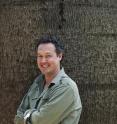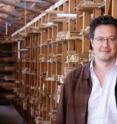Using DNA in fight against illegal logging
Advances in DNA 'fingerprinting' and other genetic techniques led by Adelaide researchers are making it harder for illegal loggers to get away with destroying protected rainforests. DNA fingerprinting for timber products has grown in international recognition due to research led by the University of Adelaide that traces individual logs or wood products back to the forests where they came from.
Professor Andrew Lowe, Director of the University's Australian Centre for Evolutionary Biology and Biodiversity, and Dr Hugh Cross, Molecular Biologist at the State Herbarium of South Australia, have been working with Singapore company Double Helix Tracking Technologies (DoubleHelix), a leader in applied genetics for forest trade and conservation.
In a new paper published in the journal of the International Association of Wood Anatomists, Professor Lowe and Dr Cross say DNA science has made a number of key advances in the fight against illegal loggers.
"Molecular marker methods have been applied to freshly cut wood for a number of years, and it's now also possible to extract and use genetic material from wood products and old samples of wood," Professor Lowe says.
"We can use 'DNA barcoding' to identify species, 'DNA fingerprinting' to identify and track individual logs or wood products, and we can also verify the region the wood was sourced from.
"The advancement of genetics technologies means that large-scale screening of wood DNA can be done cheaply, routinely, quickly and with a statistical certainty that can be used in a court of law. Importantly, these methods can be applied at a customs entry point to the country – certification documents can be falsified, but DNA cannot."
An estimated 10% of wood imported into Australia consists of illegally traded timber, which has been cut down outside designated logging areas or outside agreed environmental controls. Australian companies have been the first in the world to purchase timber products that use DNA fingerprinting, as part of proof of legal origin starting back in 2007 – European and American importers are now following suit.
Jonathan Geach, a Director of DoubleHelix, says: "As the technology is now proven scientifically and commercially, we're looking at a large-scale application in the Congo Basin, as well as working with governments in Europe and America to tighten the grip on illegal timber trade.
"Having Professor Lowe as a leading researcher from the University of Adelaide and as an active member of our team has been tremendously important in driving the role of DNA tracing in timber internationally."
Professor Lowe says a number of improvements in genetic marker methods still need to be made, such as for old or degraded wood samples. "Nevertheless, the advances in the use of DNA to identify wood are exciting," he says.
This research is closely aligned with another major project, to develop a 'DNA barcode' for every tree and grass species on earth. "The Barcode of Life projects will take five years to complete, but the information will lead to a step change in the way we can manage our species and ecosystems right across the globe," Professor Lowe says.
Source: University of Adelaide
Other sources
- DNA barcodes save rainforestsfrom Science AlertSun, 3 Jul 2011, 14:30:26 UTC
- DNA used as weapon against illegal loggingfrom UPIFri, 1 Jul 2011, 8:10:19 UTC
- Using DNA in fight against illegal loggingfrom Biology News NetFri, 1 Jul 2011, 1:00:25 UTC
- DNA used as weapon against illegal loggingfrom UPIThu, 30 Jun 2011, 22:30:39 UTC
- Using DNA in fight against illegal loggingfrom Science DailyThu, 30 Jun 2011, 17:30:52 UTC
- Using DNA in Fight Against Illegal Loggingfrom Newswise - ScinewsThu, 30 Jun 2011, 14:00:34 UTC
- Using DNA in fight against illegal loggingfrom PhysorgThu, 30 Jun 2011, 11:00:24 UTC

